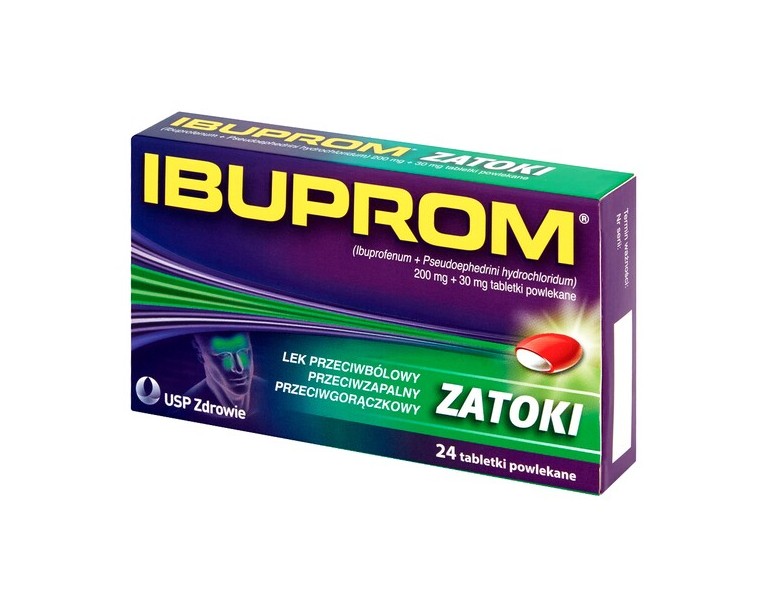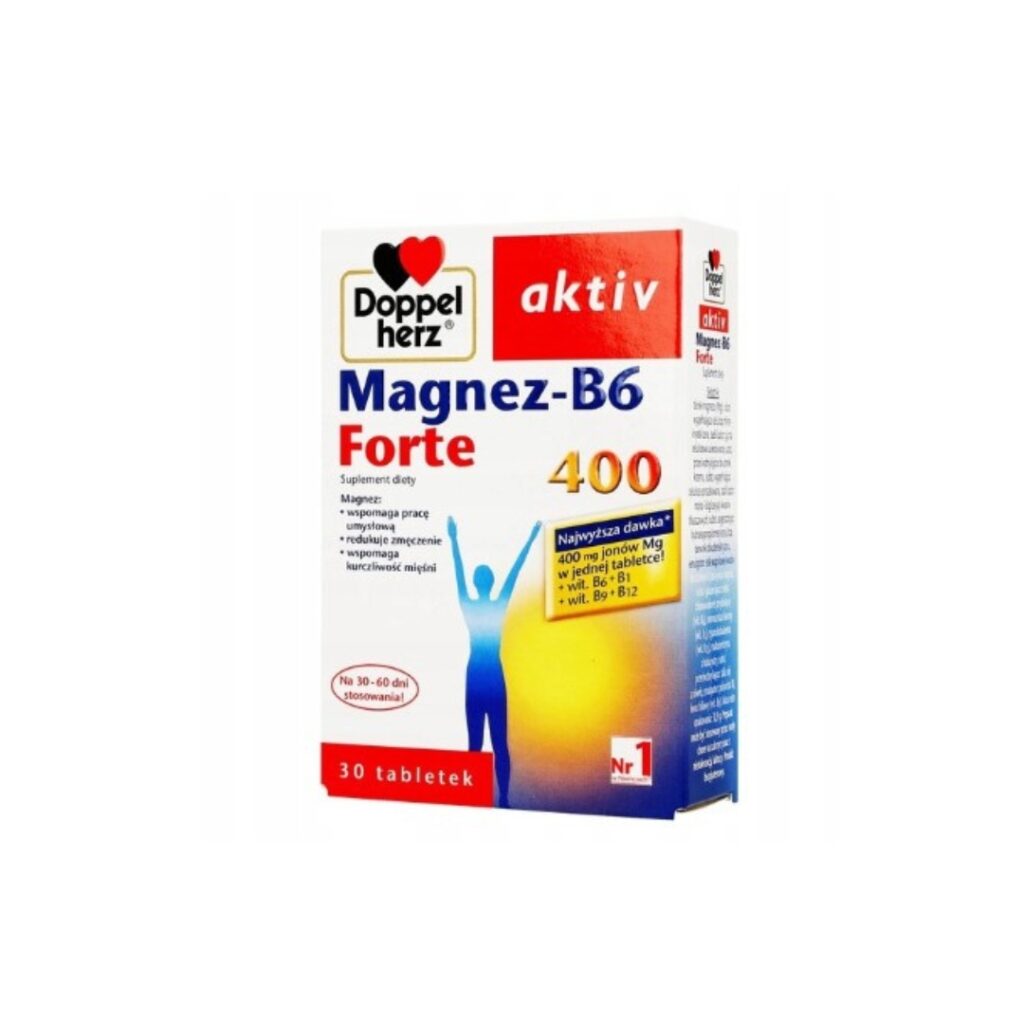Ibuprom Zatoki is a drug intended for emergency use to relieve the symptoms of colds and flu, such as:
- Headache,
- pain and obstruction of the paranasal sinuses,
- runny nose,
- fever,
- sore throat,
- muscle pain.
Short-term treatment of sinusitis symptoms such as:
- Headache,
- Painful sinus and nasal obstruction as a result of complications from colds, flu or allergic rhinitis.
When to use Ibuprom Zatoki
Ad hoc to relieve the symptoms of colds and flu, such as: headache, pain and obstruction of the paranasal sinuses, runny nose, fever, sore throat, muscle pain.
Active substance: Ibuprofen, Pseudoephedrini hydrochloridum
What are the contents of Ibuprom Zatoki?
One coated tablet contains as active substances:
Ibuprofen (Ibuprofenum) 200 mg, pseudoephedrine hydrochloride (Pseudoephedrini hydrochloridum) 30 mg, excipient with known effect: sucrose and sunset yellow (E110).
| One film-coated tablet contains: | Ibuprofen (Ibuprofen) 200mg |
| pseudoephedrine hydrochloride (Pseudoephedrini hydrochloridum) 30 mg | |
| The other excipients are: powdered cellulose (Elcema P-100), powdered cellulose (Elcema F-150), corn starch, pregelatinized starch, guar gum, talc, croscarmellose sodium, crospovidone, colloidal hydrated silica, hydrogenated vegetable oil.
Shell composition: hydroxypropyl cellulose, macrogol 400, talc, gelatin, sucrose, kaolin, confectioner’s sugar (a mixture of sucrose and corn starch), calcium carbonate, Opaglos Clear GS-2-0750 (a mixture of carnauba wax, white wax and ethanol contaminated with methanol), gum spray-dried arabic, corn starch, Opalux Brown AS-16518 (mixture of sucrose, titanium dioxide (E171), sunset yellow lake (E110), allura red lake (E129), indigo carmine lake (E132), povidone, sodium benzoate (E211)) . Printing ink composition: Opacode Black S-1-17823 (a mixture of shellac, black iron oxide (E172), n-butyl alcohol, isopropyl alcohol, 28% ammonium hydroxide, propylene glycol, ethanol). |
How to use Ibuprom Zatoki?
Adults and children over 12 years of age: 1 to 2 tablets orally every 4 hours after meals. Do not use more than 6 tablets per day (maximum daily dose of 1200 mg ibuprofen and 180 mg pseudoephedrine hydrochloride in divided doses). The medicinal product should not be given to children under 12 years of age.
Elderly: No dosage adjustment is required unless renal or hepatic function is impaired. In this case, the doctor should determine the dosage individually for the patient.
The lowest effective dose should be used for the shortest duration to relieve symptoms. If the medicinal product is required for more than 3 days or if the patient’s condition worsens, the patient should contact a physician.
When should Ibuprom Zatoki not be used?
The medicinal product is contraindicated in patients:
- with hypersensitivity to the active substances or any of the excipients;
- who have ever had allergic symptoms in the form of a runny nose, hives or bronchial asthma after taking acetylsalicylic acid or other non-steroidal anti-inflammatory drugs (NSAIDs);
- with active or history of gastric and/or duodenal ulcer, perforation or bleeding, including those occurring after the use of NSAIDs;
- with a bleeding diathesis;
- with severe hepatic insufficiency, severe renal insufficiency or severe heart failure,
- during pregnancy and during breastfeeding;
- taking other non-steroidal anti-inflammatory drugs at the same time, including COX-2 inhibitors (increased risk of side effects);
- with severe disorders of the cardiovascular system, tachycardia, arterial hypertension, angina pectoris;
- with hyperthyroidism;
- with diabetes;
- with angle-closure glaucoma;
- with prostatic hyperplasia;
- with pheochromocytoma of the adrenal gland.
Contents
Brick red ellipsoidal tablets imprinted with IB Z on one side
Storage method
Below 25°C
Manufacturer
US PHARMACIA
Warnings for Ibuprom Zatoki
Caution should be exercised in patients:
- who have systemic lupus erythematosus and mixed connective tissue disease due to an increased risk of developing aseptic meningitis;
- with a history of gastrointestinal diseases (ulcerative colitis, Crohn’s disease) due to the possibility of exacerbation of the disease;
- who have a history of hypertension and/or cardiac dysfunction due to possible fluid retention and edema related to NSAIDs;
- who have impaired kidney function due to the risk of further deterioration of kidney function;
- who have impaired liver function;
- with active or history of bronchial asthma and allergic diseases due to the possibility of bronchospasm;
- in the elderly due to the risk of increased side effects;
- taking certain medications.
Taking the medicinal product at the lowest effective dose for the shortest period necessary to relieve symptoms reduces the risk of side effects (see gastrointestinal and cardiovascular effects below).
There is a risk of gastrointestinal haemorrhage, ulceration or perforation, which may be fatal and may not necessarily be preceded by warning symptoms or may occur in patients with such warning symptoms. If gastrointestinal haemorrhage or ulceration occurs, treatment should be discontinued immediately. Patients with a history of gastrointestinal disease, particularly the elderly, should be advised to report any unusual gastrointestinal symptoms (especially bleeding) to their physician, especially at the beginning of therapy. These patients should use the lowest dose possible. Caution should be exercised when administering the medicinal product to patients who are taking other drugs concomitantly.
Impact on the circulatory system and cerebral vessels:
Clinical trials and epidemiological data suggest that the use of ibuprofen, especially at high doses (2400 mg/day) over long periods of time, may be associated with a slightly increased risk of arterial thrombosis (e.g. myocardial infarction or stroke). Overall, epidemiological studies do not suggest that low doses of ibuprofen (e.g. < 1200 mg daily) are associated with an increased risk of myocardial infarction.
Special care should be taken (patient should consult a doctor or pharmacist) before using the medicinal product in patients with a history of hypertension and/or heart failure with fluid retention, hypertension and edema related to NSAID use.
There is evidence that drugs that inhibit cyclo-oxygenase (prostaglandin synthesis) may cause impairment of female fertility by affecting ovulation. This effect is transient and disappears after discontinuation of therapy.
The simultaneous, long-term use of different painkillers may lead to kidney damage with the risk of kidney failure (post-analgesic nephropathy).
Severe skin reactions, some of them fatal, including exfoliative dermatitis, Stevens-Johnson syndrome and toxic epidermal necrolysis, have been reported very rarely with the use of NSAIDs. The highest risk of these serious reactions occurs early in therapy, in most cases within the first month of use. Discontinue use at the first appearance of skin rash, mucosal lesions or other signs of hypersensitivity.
The product should be used with caution in patients taking tricyclic antidepressants and other sympathomimetic drugs (medicines that decongest the blood vessels of the mucous membranes), appetite suppressants, amphetamine-like drugs, psychotropic drugs.
Due to the sucrose content of the medicinal product, patients with rare hereditary problems of fructose intolerance, glucose-galactose malabsorption or sucrase-isomaltase insufficiency should not take this product. The presence of Sunset Yellow (E110) may cause allergic reactions.
Usage during pregnancy and breastfeeding
Due to the possible association between fetal malformations and exposure to pseudoephedrine during the first trimester of pregnancy, and although ibuprofen has not been shown to be teratogenic in animal studies, this medicinal product should not be used during pregnancy.
Both ibuprofen and pseudoephedrine are excreted in breast milk in small amounts. The use of the medicinal product in breast-feeding women is not recommended.
Driving
Caution should be exercised when driving a car or operating machinery while taking the medicinal product.
Overdosage
In acute overdose, symptoms depend on the amount ingested and the time elapsed since ingestion. The first symptoms that usually occur are: severe nausea, vomiting, headaches and dizziness, epigastric pain, increased blood pressure, increased heart rate.
In case of gross overdose (for ibuprofen over 400 mg/kg), coma, tachycardia, hyperkalaemia with arrhythmias, metabolic acidosis, fever, respiratory disorders and renal dysfunction may occur. Haemolytic anemia, granulocytopenia and thrombocytopenia may occasionally occur after prolonged use. If acute overdose has not elapsed more than 1 hour, it is recommended to induce vomiting, gastric lavage or administration of activated charcoal.
There is no antidote or specific treatment for overdose. Symptomatic treatment consists in monitoring vital functions with particular emphasis on blood pressure measurement, ECG and analysis of symptoms indicating the possibility of gastrointestinal bleeding, metabolic acidosis and central nervous system disorders. In the case of significant stimulation caused by pseudoephedrine and no contraindications typical for benzodiazepines, it is possible to administer drugs from this group.
Interactions with other drugs
Ibuprom Zatoki should not be used in combination with a monoamine oxidase inhibitor and for up to 14 days after stopping taking this inhibitor. Hypertensive crises may occur during concomitant use of a monoamine oxidase inhibitor and sympathomimetic drugs.
Due to the content of pseudoephedrine, the concomitant use of Ibuprom Zatoki with the following drugs is not recommended due to the increased risk of vasoconstriction and increase in blood pressure:
- dopamine receptor agonists, ergot alkaloid derivatives – bromocriptine, cabergoline, lisuride, pergolide;
- dopaminergic vasoconstrictors – dihydroergotamine, ergotamine, methylergometrine;
- linezolid;
- nasal decongestants (oral or nasal),
- phenylephrine, ephedrine, phenylpropanolamine.
Caution should be exercised when using Ibuprom Sinus with the following
drugs:
- acetylsalicylic acid, other non-steroidal anti-inflammatory drugs or glucocorticoids; the use of these drugs in combination with ibuprofen may increase the risk of gastrointestinal side effects;
- acetylsalicylic acid in cardioprotective doses: chronic use of ibuprofen may inhibit the anticoagulant effect of acetylsalicylic acid;
- antihypertensives and diuretics: ibuprofen (like other non-steroidal anti-inflammatory drugs) may reduce the effect of these drugs;
- anticoagulants;
- lithium: there is evidence of a potential increase in lithium plasma concentrations when ibuprofen is taken concomitantly (as with other non-steroidal anti-inflammatory drugs);
- methotrexate: there is a risk of increasing the concentration of methotrexate in the blood plasma during the concomitant use of ibuprofen (similar to other non-steroidal anti-inflammatory drugs);
- zidovudine: there is evidence of an increased risk of joint haemorrhages and hematomas in haemophiliac HIV-positive patients taking zidovudine and ibuprofen concomitantly;
- quinidine.
The following drugs are not recommended to be used concomitantly with pseudoephedrine:
- appetite suppressants (pseudoephedrine may increase their effect);
- amphetamine-type psychostimulants (pseudoephedrine may increase their effect);
- antihypertensives, alpha-methyldopa, mecamilamine, reserpine, hellebore alkaloids,
- guanethidine (pseudoephedrine may reduce their antihypertensive effect);
- tricyclic antidepressants (pseudoephedrine may theoretically increase the risk of developing high blood pressure and arrhythmias).
Antacids increase the rate of pseudoephedrine absorption, and kaolin decreases the rate of pseudoephedrine absorption.
When halogenated gases, general inhalation anesthetics, are used in combination with pseudoephedrine, an acute hypertensive reaction in the perioperative period may occur, as when these drugs are used in combination with other indirect sympathomimetic agents. Therefore, it is recommended to discontinue Ibuprom Sinus 24 hours before scheduled general anesthesia.




